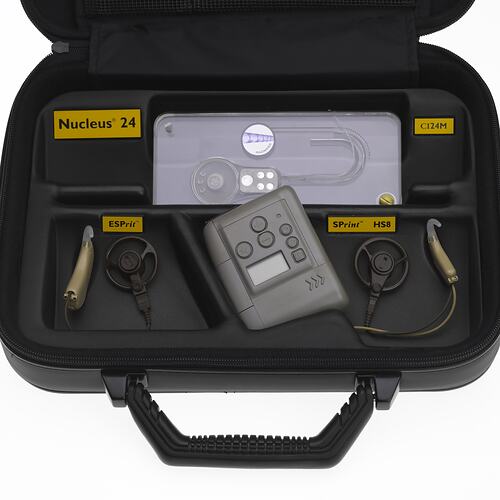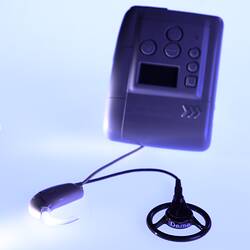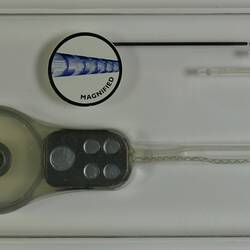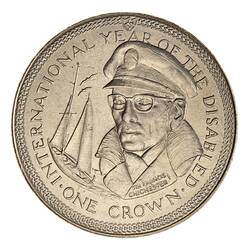Summary
Alternative name: Bionic Ear.
Cochlear implant, Nucleus 24, manufactured by Cochlear Limited in 1998. A cochlear implant is a surgically implanted electronic device that provides a sense of sound to a person who is profoundly deaf or severely hard of hearing. The cochlear implant is often referred to as a bionic ear.
The Nucleus 24 cochlear implant system is made up of a C124M implant and a choice of either the Sprint body worn speech processor or the Esprit (world's first multi-channel ear level) speech processor. The C124M implant encased in a perspex block for display purposes, has strength and impact resistence of titanium case design. The base of the implant only requires one third of the drilling required for earlier models, making it easier to implant in infants and children. The electrode array fits around and delivers the desired current to the cochlea. The Espirt is powered by two hearing aid batteries lasting 80 hours. The fingertip control unit with two selectable programs optimises listening in different environments. Fits into black carry case.
When used with a microphone and speech processor it electrically stimulates the auditory nerve and results in the person being able to hear sound. When the system was first developed in 1978 by Graeme Clark and colleagues it was referred to as the bionic ear. Since that time a variety of cochlear implants have been developed by the Cochlear division of Nucleus.
Physical Description
Titanium implant with circular end narrowing to two short cords. Incased inside a perspex block for display purposes with a metal screw and a small perspex securing pin.
Significance
Example of Australian innovation. Example of bionic ear technology. Example of contemporary medical prosthetics used in Victoria, Australia.
More Information
-
Collecting Areas
-
Acquisition Information
Donation from Cochlear Pty Ltd, by May 1998
-
Manufacturer
Cochlear Pty Ltd, 14 Mars Road, Lane Cove, Greater Sydney, New South Wales, Australia, 1997-1998
-
Inventor
Professor Graeme M. Clark AC - University of Melbourne (The), Melbourne, Victoria, Australia, 1978
-
Inscriptions
On top of perspex block: "MAGNIFIED".
-
Model Name or Number
-
Brand Names
-
Classification
-
Category
-
Discipline
-
Type of item
-
Overall Dimensions
160 mm (Length), 65 mm (Width), 15 mm (Height)
-
Keywords
Disabilities, Ears, Hearing Aids, Hearing Impaired, Innovations, Innovation & Design






